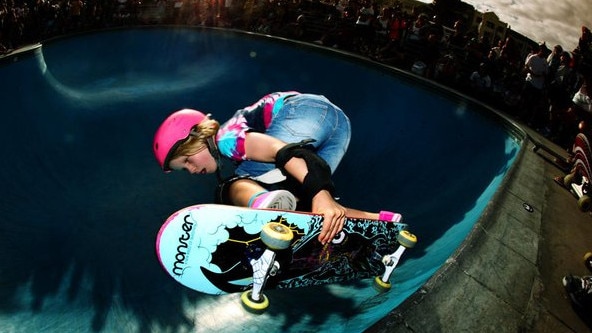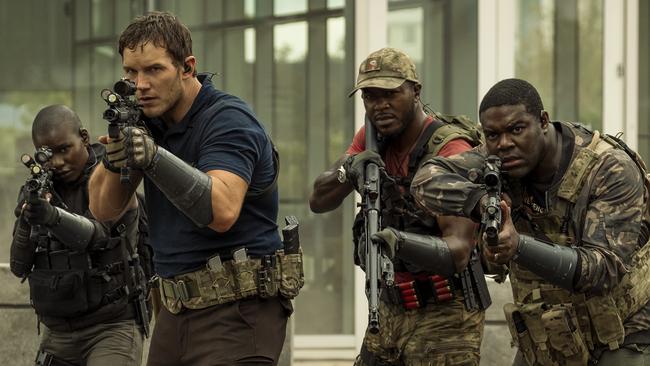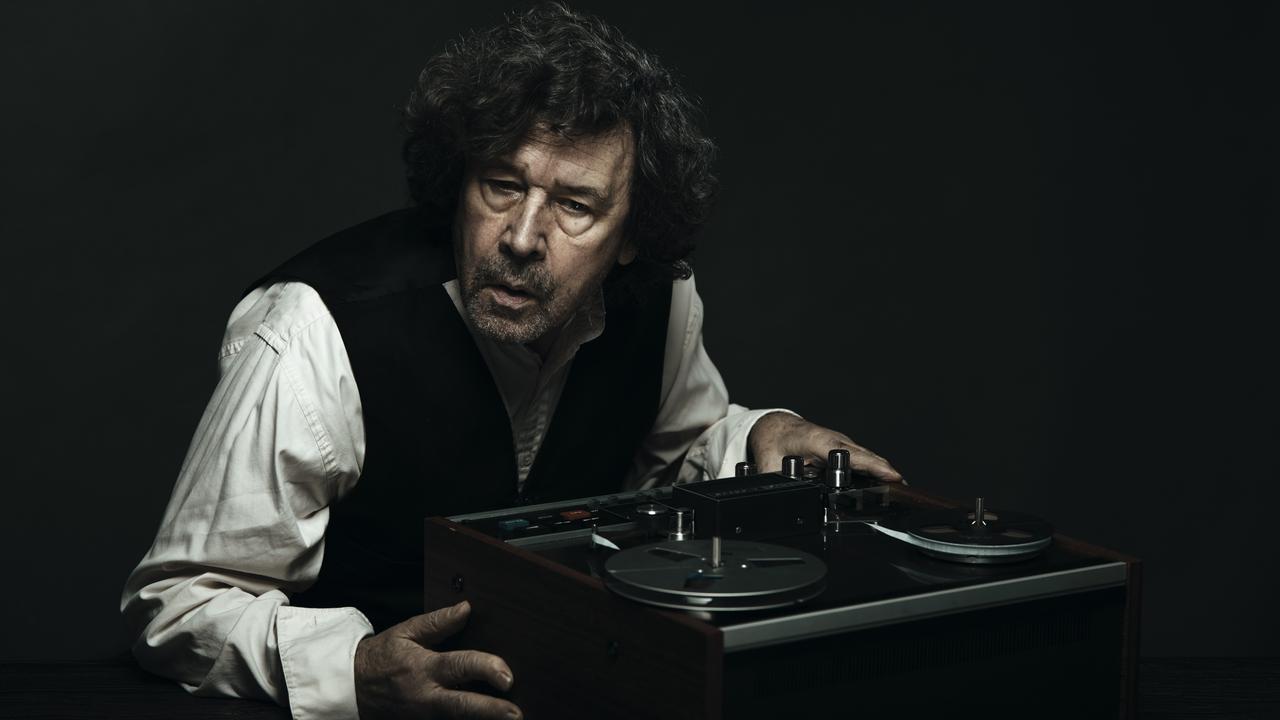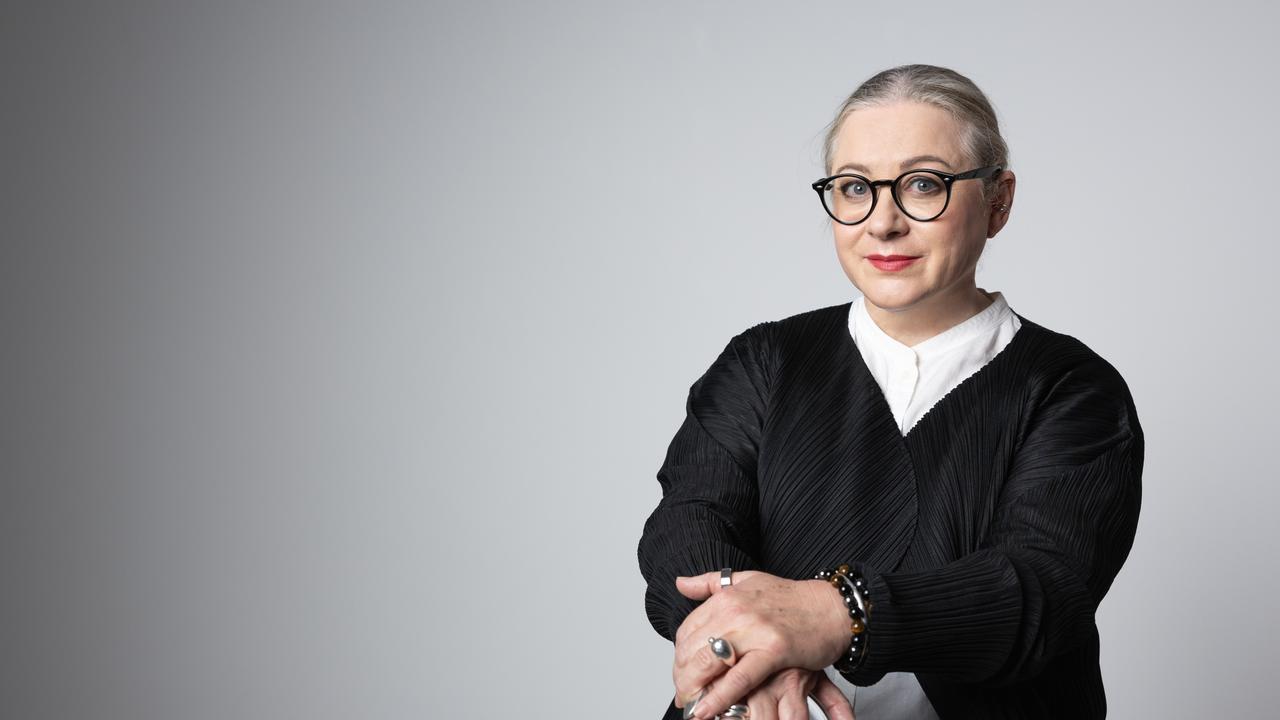Reviews, Tall Poppy: A Skater’s Story and The Tomorrow War
“The more you skate, the less scared you get,’’ said an eight-year-old Poppy Starr Olsen. Now, at 21, she’s skating for Australia.

Tall Poppy: A Skater’s Story (CTC)
In cinemas
★★★½
Unless something unexpected happens, 21-year-old skateboarder Poppy Starr Olsen will represent Australia next month at the Tokyo Olympics. Her event, women’s park skateboarding, is scheduled for August 4.
It’s the first time the sport has been included in the Games and I’m sure she will wear the national green and gold with pride. Yet, having watched an immersive documentary about her life to date, I’d like to see her compete in the emblazoned T-shirts she wears throughout: Girl Is Not a 4 Letter Word, Pretty Radical, No Regrets.
“You’re skating for something else,’’ the late-teen Poppy says as the Olympics become a possibility. “You’re skating for Australia.” Later, though, when she is a few years older and has grown up quite fast, she muses, “I’m back to doing it for myself again.” Whether that puts her on the medals podium time soon will tell. Tall Poppy: A Skater’s Story, directed by Sydney filmmaker Justine Moyle, shows us how she made it to where she is today. It is an inspiring story at a time when we need them.
The 90-minute film starts in 2008, when Poppy is eight and picks up a skateboard for the first time. It ends in June this year, when she is 21, ranked No.4 in the world and locked in as an Olympian.
Poppy grew up in Sydney’s Bondi Beach and started out at its famous skate park, known as the “Bondi Bowl”. The footage from this time shows her falling off her skateboard, but not for long. It is impressive how quickly she becomes a skilled skater. “The more you skate, the less scared you get,’’ she says. This early observation, from an eight-year-old, suggests why she became so good. As we follow her through her childhood and teen years, it is obvious she is intelligent, artistic (she designed the title fonts for this film), self-confident and at the same time self-aware. At one point she talks about how art and skateboarding are connected. “There are no rules. You can do whatever you want. You can feel free.”
Yes and no, as she will find out. From the outset she is backed by her parents, particularly her mother Kate, who calls herself Thomas (for reasons that are not explained). “As a parent, there is a fine line between pushing and encouraging,” she says. Poppy’s thoughts on this are characteristic: “She annoys the crap out of me sometimes but that’s just being a teenager I think.” There are times when I think Mum does wander a little over that line, but perhaps it is necessary.
When Poppy is chosen for the Olympics and chooses a coach, family friend Alex Donnini, he puts it plainly. “Poppy has to understand it is a different job now. It’s a government job. They’ve given you money. They don’t want to hear about fun and play. They want to hear about results.”
We follow Poppy on the tournament circuit in Australia and overseas. The cinematography, led by Dane Howell, is thrilling. It’s like a surfing film (and skateboarding started from surfing) on concrete.
When her parents divorce, Poppy and her mum and two younger siblings move to Newcastle. Her dad, Andrew, soon moves nearby and remains an important part of her life.
Poppy competes in the US, Europe, South America and China. At 18, she meets a Canadian skater, Una Farrar. Their relationship becomes an important part of the story, especially when COVID-19 separates them. I’ve said before that for a sports film to work, it has to appeal to people with little interest in the sport. This one works so well because it is about a remarkable young Australian woman who happens to be a champion skateboarder.
She is open and honest. She knows she still has a lot to learn, as a skateboarder and as a person. When asked, right at the end, what she plans to do after the Olympics, her reply is simple and beautiful.
At the same time, this documentary did interest me in the sport. It made me want to find out more about skateboarding and skateboarders. I’d like to know if there are different kinds of boards, different types of wheels, what moves are worth the most points and so on.
I’d like to know more about the other skaters we see, such as Newcastle’s Sabre Norris, who at 12 years old thrashes 17-year-old Poppy in a competition. Her moves are amazing to watch. That’s what Google is for, I suppose. I did read up on Sabre and her story is a sad one.
This movie is in cinemas for a short time. Poppy, who is in the US, is due to do a public Q&A via Zoom after a screening today. With lockdowns back in the news, it’s best to check screening times via www.madmanfilms.com.au/tall-poppy.
After seeing this film, I called an old friend whose son, a few years older than Poppy, is a keen skateboarder. He told me his son hung out a bit with Poppy in the Bondi days. “She skated his arse off.” That sounds about right. Now Poppy has the chance to do the same with the whole world watching.
-
The Tomorrow War (CTC)
Amazon Prime
★★★½
“I wish Stevie Nix would show up in her birthday suit with a jar of pickles and a bottle of baby oil.” So says estranged father James Forester (Oscar winner JK Simmons) to his adult son Dan Forester (Chris Pratt) when they first meet in the sci-fi action thriller The Tomorrow War.
I open with that quote for two reasons. First, it shows this time-warping movie, which plot-wise swings between being scarily possible and laughably impossible, comes with a sense of humour.
Second, it’s JK Simmons! I have followed his career since he was the white supremacist Vernon Schillinger in the brutal American prison drama Oz (1997-2003) and any scene in any film with him in it is worth watching. His character becomes important towards the end of The Tomorrow War and it’s worth waiting for.
In that initial scene, his son has come to him for help. He has just been drafted into a worldwide army to fight aliens and is thinking of doing a runner. His father, who has a masters in engineering and a suspicion of the US government, might be able to unlock the tracking (and time travelling) bracelet on his wrist.
It has the time travel inclusion because, as the title suggests, this is a war being fought in the future. In December 2022, a group of soldiers materialise on the pitch during the football World Cup. After unintentionally thwarting a certain goal for Brazil, they issue a warning and make a plea for help.
“We are you 30 years in the future,’’ their leader says. “We are fighting a war. Our enemy is not human. We are losing.” She adds that if this continues, the human race will be extinct in less than a year.
Remarkably, world leaders not only believe her but agree to form a global army that can be dispatched to fight a war that will start not tomorrow or the next day, but (we learn later) in 2048.
Even more remarkably, everyone listens to the scientific consensus that this sort of jumping through time is possible, that the aliens are real and that human extinction is on the cards.
Well, almost everyone. An anti-war movement starts up, perhaps via Twitter. “Why should we be fighting a war that hasn’t yet happened?” one protester asks. It’s a reasonable question … until the scientists construct a wormhole into time and world leaders start sending soldiers off to fight this future war.
They soon find out the aliens are real, have been on earth for quite a while and are wiping us out. In an aside, Australia is mentioned as one of the countries where there are no longer any humans.
The invaders, dubbed White Spikes (they look a bit like super-vicious white griffins), are tough. The military body count is so high that a global draft is announced to dragoon ordinary citizens into the conflict.
This is where Dan, unable to do that runner, comes in. He is a high school biology teacher with a wife and nine-year-old daughter.
He was also a special operations soldier in Iraq, which is lucky for us, less so for the aliens. In a funny moment, the recruitment officer says, “Thank you for your service … again”. His dad is a Vietnam War veteran, which might also come in handy.

At that point Dan and a group of fellow civilians are zapped to 2051, the only open portal (“If it wasn’t a war, we’d still be using lab rats,’’ a scientist confesses), on a one-week tour of duty. The statistics tell them that the survival rate on such missions is 30 per cent.
The visual effects, put together by firms in Australia and New Zealand, are spectacular. The scene where the conscripts land in war-ravaged Miami made me think not of a sci-fi film but of the Omaha beach landing in Steven Spielberg’s Saving Private Ryan.
The kill-all-aliens mission is commanded by Colonel Forester (Australian actor Yvonne Strahovski aka Serena Waterford in The Handmaid’s Tale). So this soldier in the future, who is also a scientist, shares the same surname as the soldier turned science teacher Dan. Is this a coincidence? That’s for viewers to find out but I will add that by this point, 2051, the White Spikes have been busy and the global population is down to 500,000.
I confess that time-bending plots do my head in a bit. If the people zapped from 2022 to 2051 can work out how to defeat the aliens, does that mean the 2048 invasion will be stopped before it starts? If so, does that mean what we are seeing in 2051, the existential shootouts with the White Spikes, does not happen? Either way, will Stevie Nix turn up?
It’s best just to go along for the ride. This 138-minute movie, the live action debut of American filmmaker Chris McKay (The Lego Batman Movie), is a fast-paced, high tension thriller with strong emotional moments between Dan and the colonel who shares his surname and between Dan and his father.
There are some good surprises, too. When we find out why the aliens are killing us, for example, it’s not for the reason we expect.



